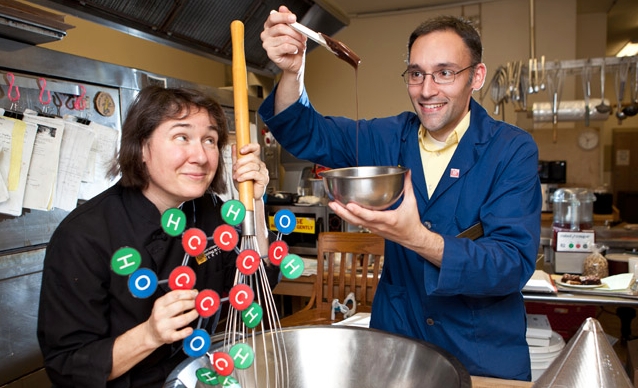
Four years ago, Assistant Chemistry Professor Justin Lytle started the “Chemistry of Food” series with Erica Fickeisen, lead baker with PLU’s Dining and Culinary Services.(Photo by John Froschauer)
The right recipe for fun and learning
The recipe for how Assistant Professor of Chemistry Justin Lytle teaches looks a little like this: Add two-parts enthusiasm and a love of teaching, one-part knowledge of the sciences, and a heaping scoop of passion for the chemistry of food. Then sprinkle in a little dry humor, and mix slowly.
Lytle’s true calling is sharing his passion for the sciences with students. His teaching philosophy is that chemistry doesn’t have to be intimidating. It can and should be fun and engaging.
And tasty.
“Chemistry is so scary for a lot of college students,” Lytle said. “I want my students to say ‘I enjoy what I’m learning and I can do anything that I put my mind to.’”
In food, he sees a way for his students to relate cooking to its most basic level – the chemical makeup of food. Chemistry is, after all, how the building blocks of nature go together to form, well, everything.
Lytle deliberately emphasizes that students know more about chemistry than they think. Like cooks, chemists choose and measure ingredients, modify recipes, adjust cooking times and temperatures, and test the end results. Constructing and deconstructing food is chemistry.
“It is a way to tone down the science and make it accessible.”
For instance, anyone who stops by his office is likely to get a noseful.
Lytle likes to get his guests to sniff two different molecules built from two isoprene molecules each – pinene and limonene. At the molecular level pinene and limonene are almost identical, except for the fact that their building blocks connect to each other in slightly different ways. The results are molecules that are structurally similar, but their scent is radically different: Pinene and limonene smell like pine and citrus.
“Nature is using the same building blocks, but in slightly different configurations,” he said.
This type of instruction doesn’t just happen in the chemistry classrooms of Rieke Science Center. It is also happening in PLU’s dining commons. Four years ago, Lytle started the “Chemistry of Food” series with Erica Fickeisen, lead baker with PLU’s Dining and Culinary Services.
Lytle, Fickeisen, and Dining and Culinary Services have joined together to create fun, informative sessions – open to the entire campus – that look at the chemistry of different foods, like cheese, chocolate, spices and bread.
Take chocolate, for instance. Lytle and Fickeisen deconstruct chocolate into its many components – one of which is a key ingredient in nail-polish remover – and they demonstrate how slight differences in the origin of the cacao beans, or even the processing temperature, change the mouth feel and flavor of the chocolate.
Students aren’t the only ones who learn during these demonstrations. Lytle found he enjoyed chocolate even more after learning about how subtly complex it is.
“It’s so much more rich than I thought,” he said. “One more reason I love chocolate.”
The sessions can be quite a challenge to put on, but Lytle and Fickeisen really love how the enjoyment of food makes chemistry more palatable.
Lytle credits Fickeisen and PLU’s Dining Services with coming up with some delicious foods as culinary examples for the talks. “Erica and Dining Services are my partners in crime,” Lytle said. “It’s a real labor of love. It’s absolutely a lot of work, but when we pull it off, it’s really something special.”
He’s not sure what’s next on the menu, but that’s the fun of it. The recipe is always changing.


